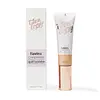What's inside
What's inside
 Key Ingredients
Key Ingredients

No key ingredients
 Benefits
Benefits

 Concerns
Concerns

 Ingredients Side-by-side
Ingredients Side-by-side

Water
Skin ConditioningCaprylyl Methicone
Skin ConditioningDimethicone
EmollientPolymethylsilsesquioxane
Isononyl Isononanoate
EmollientPEG/PPG-18/18 Dimethicone
EmulsifyingGlycerin
HumectantPropylene Glycol
HumectantC30-45 Alkyldimethylsilyl Polypropylsilsesquioxane
Caprylic/Capric Triglyceride
MaskingLauryl PEG-10 Tris(Trimethylsiloxy)Silylethyl Dimethicone
EmulsifyingZinc Stearate
Cosmetic ColorantSodium Chloride
MaskingStearalkonium Hectorite
Gel FormingSilica Silylate
EmollientPropylene Carbonate
SolventDisodium EDTA
Triethoxycaprylylsilane
Ethylhexylglycerin
Skin ConditioningPhenoxyethanol
PreservativeCI 77891
Cosmetic ColorantCI 77499
Cosmetic ColorantCI 77491
Cosmetic ColorantCI 77492
Cosmetic ColorantWater, Caprylyl Methicone, Dimethicone, Polymethylsilsesquioxane, Isononyl Isononanoate, PEG/PPG-18/18 Dimethicone, Glycerin, Propylene Glycol, C30-45 Alkyldimethylsilyl Polypropylsilsesquioxane, Caprylic/Capric Triglyceride, Lauryl PEG-10 Tris(Trimethylsiloxy)Silylethyl Dimethicone, Zinc Stearate, Sodium Chloride, Stearalkonium Hectorite, Silica Silylate, Propylene Carbonate, Disodium EDTA, Triethoxycaprylylsilane, Ethylhexylglycerin, Phenoxyethanol, CI 77891, CI 77499, CI 77491, CI 77492
Water
Skin ConditioningCyclopentasiloxane
EmollientGlycerin
HumectantIsododecane
EmollientSd Alcohol 40-B
AstringentAluminum Starch Octenylsuccinate
AbsorbentPolyglyceryl-4 Isostearate
EmulsifyingPEG-10 Dimethicone
Skin ConditioningCetyl PEG/PPG-10/1 Dimethicone
EmulsifyingHexyl Laurate
EmollientMagnesium Sulfate
Disteardimonium Hectorite
StabilisingPhenoxyethanol
PreservativeAcrylates/Dimethicone Copolymer
Skin ConditioningPropylene Carbonate
SolventTrihydroxystearin
Skin ConditioningTocopheryl Acetate
AntioxidantNylon-12
Ethylhexylglycerin
Skin ConditioningCellulose Gum
Emulsion StabilisingSodium Hyaluronate
HumectantAluminum Hydroxide
EmollientDisodium Stearoyl Glutamate
CleansingTitanium Dioxide
Cosmetic ColorantCI 77492
Cosmetic ColorantCI 77491
Cosmetic ColorantCI 77499
Cosmetic ColorantWater, Cyclopentasiloxane, Glycerin, Isododecane, Sd Alcohol 40-B, Aluminum Starch Octenylsuccinate, Polyglyceryl-4 Isostearate, PEG-10 Dimethicone, Cetyl PEG/PPG-10/1 Dimethicone, Hexyl Laurate, Magnesium Sulfate, Disteardimonium Hectorite, Phenoxyethanol, Acrylates/Dimethicone Copolymer, Propylene Carbonate, Trihydroxystearin, Tocopheryl Acetate, Nylon-12, Ethylhexylglycerin, Cellulose Gum, Sodium Hyaluronate, Aluminum Hydroxide, Disodium Stearoyl Glutamate, Titanium Dioxide, CI 77492, CI 77491, CI 77499
Ingredients Explained
These ingredients are found in both products.
Ingredients higher up in an ingredient list are typically present in a larger amount.
Ci 77491 is also hydrated iron III oxide. It's sole purpose is to give a red/pink hue to products.
Iron III oxides are classified as inorganic chemicals for coloring.
Synthetically created Ci 77491 is considered safer than those naturally found. This is because the synthetically created version may contain less impurities. Iron oxides are generally non-toxic and non-allergenic.
Learn more about CI 77491Ci 77492 is also hydrated iron III oxide. It's sole purpose is to give a yellow hue to products.
Iron III oxides are classified as inorganic chemicals for coloring.
Synthetically created Ci 77492 is considered safer than those naturally found. This is because the synthetically created version may contain less impurities. Iron oxides are generally non-toxic and non-allergenic.
Learn more about CI 77492Ci 77499 is also hydrated iron III oxide. It is created from mixing red and black iron oxides. This helps give shades of darkness to a product.
Iron III oxides are classified as inorganic chemicals for coloring.
Ethylhexylglycerin (we can't pronounce this either) is commonly used as a preservative and skin softener. It is derived from glyceryl.
You might see Ethylhexylglycerin often paired with other preservatives such as phenoxyethanol. Ethylhexylglycerin has been found to increase the effectiveness of these other preservatives.
Glycerin is already naturally found in your skin. It helps moisturize and protect your skin.
A study from 2016 found glycerin to be more effective as a humectant than AHAs and hyaluronic acid.
As a humectant, it helps the skin stay hydrated by pulling moisture to your skin. The low molecular weight of glycerin allows it to pull moisture into the deeper layers of your skin.
Hydrated skin improves your skin barrier; Your skin barrier helps protect against irritants and bacteria.
Glycerin has also been found to have antimicrobial and antiviral properties. Due to these properties, glycerin is often used in wound and burn treatments.
In cosmetics, glycerin is usually derived from plants such as soybean or palm. However, it can also be sourced from animals, such as tallow or animal fat.
This ingredient is organic, colorless, odorless, and non-toxic.
Glycerin is the name for this ingredient in American English. British English uses Glycerol/Glycerine.
Learn more about GlycerinPhenoxyethanol is a preservative that has germicide, antimicrobial, and aromatic properties. Studies show that phenoxyethanol can prevent microbial growth. By itself, it has a scent that is similar to that of a rose.
It's often used in formulations along with Caprylyl Glycol to preserve the shelf life of products.
This ingredient is a solvent. It helps dissolve active ingredients and alter the texture of products.
Propylene Carbonate is commonly used in makeup and with clay, such as montmorillonite or bentonite.
Studies show this ingredient to be safe for cosmetics. When it is undiluted, it can cause skin irritation. (It is always diluted in skincare and makeup). This ingredient is water-soluble.
Propylene Carbonate is created from propylene glycol and carbonic acid.
Learn more about Propylene CarbonateWater. It's the most common cosmetic ingredient of all. You'll usually see it at the top of ingredient lists, meaning that it makes up the largest part of the product.
So why is it so popular? Water most often acts as a solvent - this means that it helps dissolve other ingredients into the formulation.
You'll also recognize water as that liquid we all need to stay alive. If you see this, drink a glass of water. Stay hydrated!
Learn more about Water